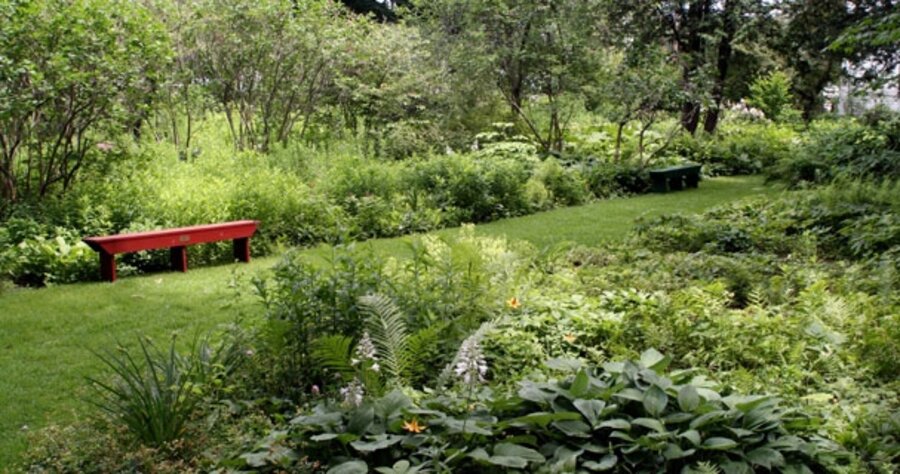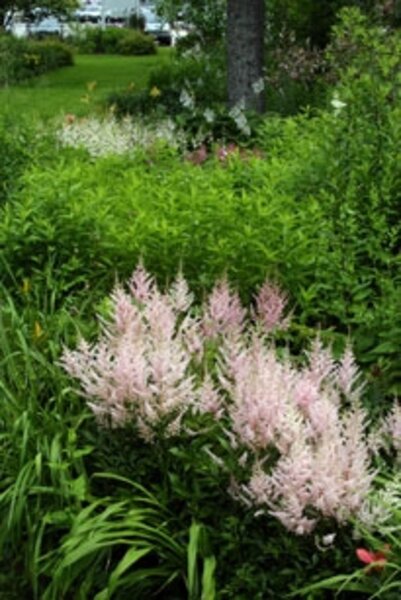From stony soil, verdant beauty
Loading...
| South Paris, Maine
In a state where gardeners are justifiably proud to coax anything, especially anything beautiful, out of their sour, stony soil and unforgiving climate, Bernard McLaughlin held an exalted status among his peers, who dubbed him the Dean of Maine Gardeners.
Mr. McLaughlin labored at humble jobs – bank teller and grocery clerk among them – but after business hours and on weekends, he poured exceptional talent and energy into his backyard, filling two acres of former farm fields and pastures with carefully chosen trees, shrubs, and perennials.
When he died in 1995, he left behind gardens that represented nearly 60 years of experimentation and accumulated knowledge, the record and product of his horticultural self-education.
The plants he chose sound conventional enough for this (Zone 4) part of the world – lilacs and azaleas, irises and peonies, roses and daylilies, sedums and asters, dogwoods, crab apples, and rhododendrons.
Over time, however, the number of species and varieties in the ever-larger beds and groves multiplied into the hundreds. His 200 lilac cultivars, for instance, compose Maine’s largest private lilac collection, and his perennial collections – hepaticas, hostas, trilliums, irises, and lilies, among others – were widely admired.
Visitors, as many as 2,000 a year, stopped by to see what he was up to. Sometimes they left with a recently divided specimen pressed on them by the gracious gardener, who presided over the Maine Iris Society for multiple terms and belonged to the American Iris Society and the American Lilac Society.
“He was definitely a collector,” says Kristin Perry, horticultural director of what is today McLaughlin Garden, operated by the private, nonprofit McLaughlin Foundation.
“He has seven different species of trillium, and I have no doubt that if he were alive today, he’d still be putting new things in the garden,” she adds.
The foundation, established by neighbors who rushed in to save the gardens after McLaughlin’s death, has rehabilitated and preserved McLaughlin’s 1848 farmhouse as well as the plants, keeping the property open to the public.
Because the garden charges no admission, the foundation relies on voluntary donations and plant sales from a small nursery and the garden’s gift shop (open all year), which fills several downstairs rooms in the farmhouse.
Visitors, arriving via a traffic-choked stretch of gas stations, auto-parts shops, and strip malls, have no trouble picturing the alternative fate of the gardens had the foundation not intervened.
Although the garden is clearly designed with an intriguing system of primary mown-grass paths sprouting secondary trails, it is not predictable in the way a professional might have planned it.
Despite the splashes of changing bloom throughout the growing season, a spirit of quiet caprice defines the series of discrete, linked spaces.
McLaughlin wove existing stone walls and cellar holes into his gardens, embellishing the mystery of these historical fragments by planting oaks, pines, and maples that cast them in tantalizing shade.
He particularly enjoyed the textural interplay of lichens, ferns, and stone in the dappled light under the canopy.
This is a garden of atmosphere, and the shade garden is its dark, mysterious heart. Framed by the barn’s broad rear door, it beckons with a view of a stone wall and a path vanishing up a pine-shaded hill, with a verdant foreground of hostas and ferns.
“That part of the garden was one of the first areas he developed, and he was using that barn door himself, coming and going with his tools, and I’m sure as he worked he was envisioning the gardens from the barn door out,” Ms. Perry observes.
In an interview with Maine garden writer Jane Lamb near the end of his life, McLaughlin declared, “I’m a foliage man.” Nowhere is that more evident than in the shade garden among the ferns, hostas, and other shade-loving species, whose mingled foliage forms a carpet as richly detailed as any woven in Turkey.
From this arrival experience, people tend to follow their eyes, usually in pursuit of color, around the side of the house or to the former pasture beyond, where beds of perennials, herbs, and the kitchen garden for the seasonal cafe occupy the property’s sunniest space.
Other visitors go immediately to a bench or follow the allure of the uphill path. (This path, known as the wildflower lane for its spring display of jack-in-the-pulpit, lady-slipper, bloodroot, trillium, and other native woodland plants, actually dead-ends halfway up the hillside. McLaughlin designed it to block a view of nearby houses.)
Throughout the progression of paths, groves, and beds, the natural materials structure the space: The mounded forms of perennials, the curving lines of paths, the prominent stones, and the trunks of mature trees provide the garden architecture.
Around the side of the house grow crab apple trees, striped maple and magnolia trees, sedums, daylilies, lilacs, and other trees and shrubs. The color throughout the gardens continues through September, which brings the purples, reds, pale and deep pinks, and blues of asters.
The marked seasonal changes echo those of the natural surroundings in Maine’s four-season climate, underscoring a sense of regional character and the fleeting beauty of growing things.
“Not a lot of gardens are as spiritual as this one,” says Perry. “It’s much more personal. You can relate to it – it has a sense of place.”






